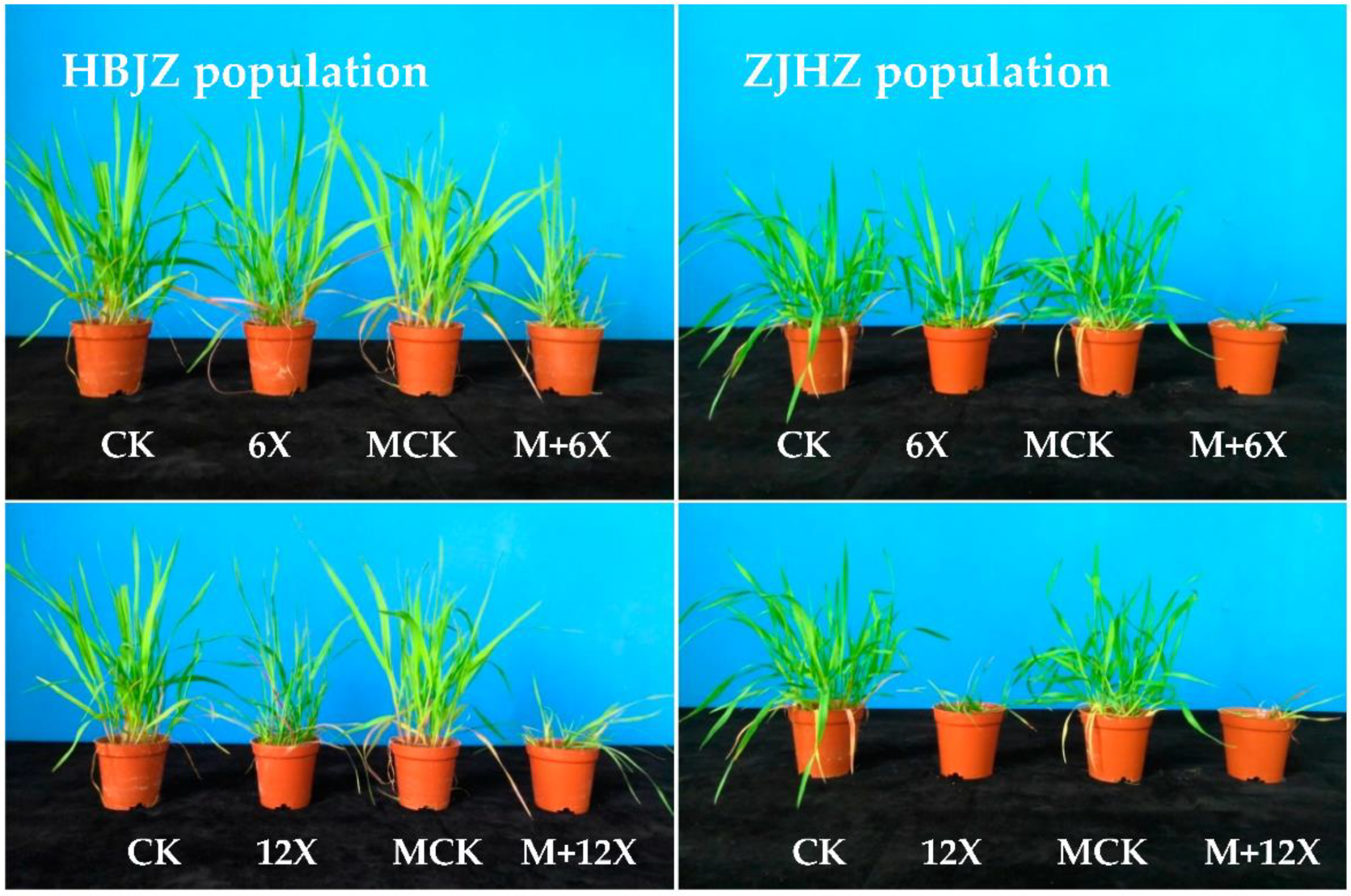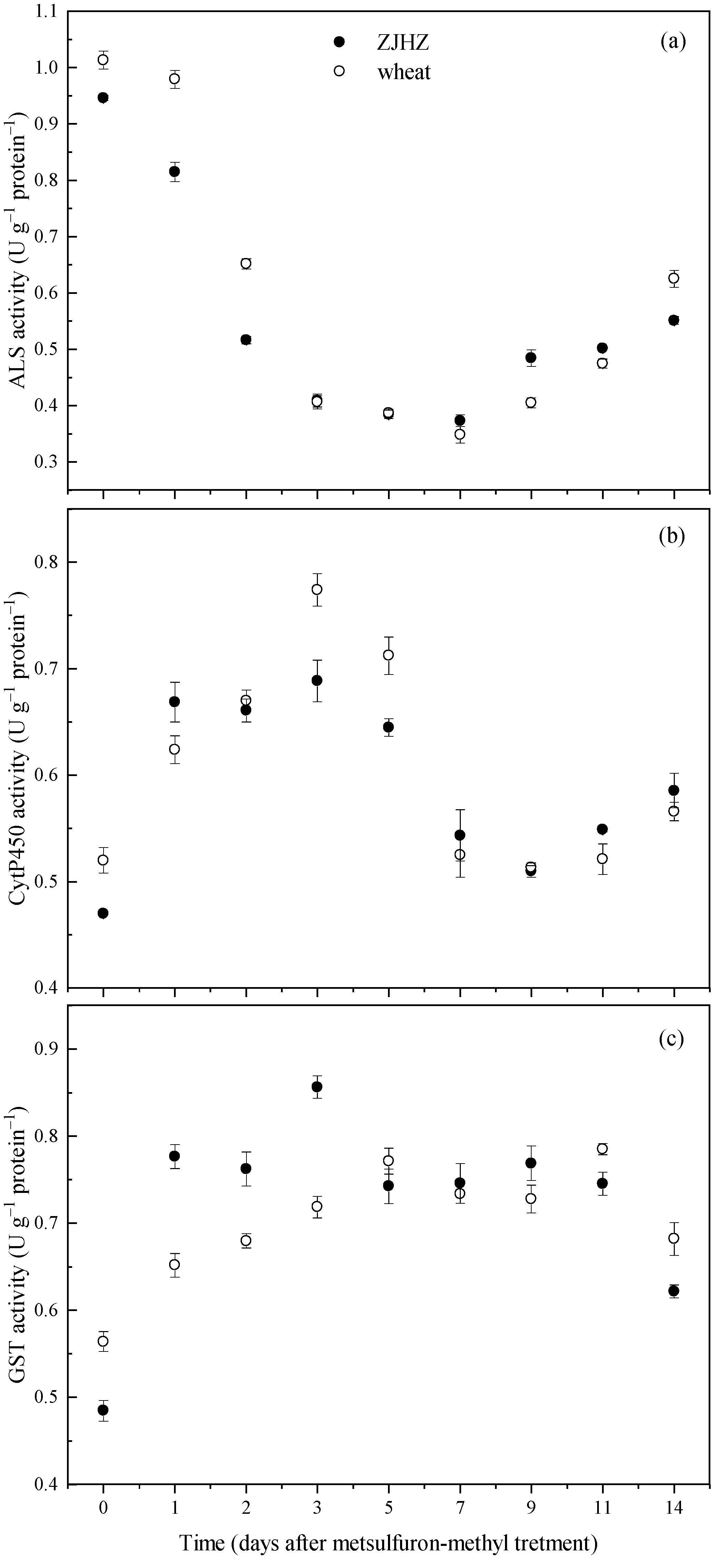The Basis of Tolerance Mechanism to Metsulfuron-Methyl in Roegneria kamoji (Triticeae: Poaceae)
Abstract
:1. Introduction
2. Results
2.1. Dose-Response to Metsulfuron-Methyl
2.2. Effect of Malathion on Metsulfuron-Methyl Tolerance
2.3. ALS Gene Amplification and Sequencing
2.4. Enzyme-Linked Immunosorbent Assay (ELISA) of ALS, CytP450 and GST Activities
2.5. Single-Dose ALS Herbicides Cross-Tolerance Testing
3. Discussion
4. Materials and Methods
4.1. Plant Materials and Growth Conditions
4.2. Dose Response to Metsulfuron-Methyl
4.3. Effect of Malathion on Metsulfuron-Methyl Tolerance
4.4. ALS Gene Amplification and Sequencing
4.5. Enzyme-Linked Immunosorbent Assay (ELISA) of ALS, CYP450 and GST Activities
4.6. Single-Dose ALS Herbicides Cross-Tolerance Testing
4.7. Statistical Analysis
Supplementary Materials
Author Contributions
Funding
Institutional Review Board Statement
Informed Consent Statement
Data Availability Statement
Acknowledgments
Conflicts of Interest
References
- Li, Y.H. Weed Flora of China; China Agriculture Press: Beijing, China, 1998; pp. 1313–1315. [Google Scholar]
- Xu, Z.H.; Qi, H.Y.; Lu, Y.L.; Yang, W.D.; Xie, G.X. Weed Identification and Management; Zhejiang University Press: Hangzhou, Chian, 2014; pp. 12–13. [Google Scholar]
- Tang, W.; Yu, X.Y.; Chen, J.; Xie, L.; Lu, Y.L. Tolerance to some ACCase inhibitors in four common Roegneria (Roegneria kamoji) populations from China. Front. Agron. 2020, 2, 587651. [Google Scholar] [CrossRef]
- Xie, Y.; Zhou, W.J.; Lu, Y.L.; Yu, X.Y.; Tang, W. Characterization of seed germination and seedling emergence of Roegneria kamoji Ohwi. J. Weed Sci. 2019, 37, 17–22. (In Chinese) [Google Scholar]
- Sasaki, Y.; Konishi, T.; Nagano, Y. The compartmentation of acetyl-coenzyme A carboxylase in plants. Plant Physiol. 1995, 108, 445–449. [Google Scholar] [CrossRef] [PubMed]
- Kaundun, S.S. Resistance to acetyl-CoA carboxylase-inhibiting herbicides. Pest Manag. Sci. 2014, 70, 1405–1417. [Google Scholar] [CrossRef] [PubMed]
- Paul, R.; Sharma, R.; Kulshrestha, G.; Singh, S.B. Analysis of metsulfuron-methyl residues in wheat field soil: A comparison of HPLC and bioassay techniques. Pest Manag. Sci. 2009, 65, 963–968. [Google Scholar] [CrossRef] [PubMed]
- Sarmah, A.K.; Kookana, R.S.; Alston, A.M. Fate and behavior of triasulfuron, metsulfuron-methyl, and chlorsulfuron in the Australian soil environment: A review. Aus. J. Agric. Res. 1998, 49, 775–790. [Google Scholar] [CrossRef]
- Tranel, P.J.; Wright, T.R. Resistance of weeds to ALS-inhibiting herbicides: What have we learned? Weed Sci. 2002, 50, 700–712. [Google Scholar] [CrossRef]
- Corbett, C.-A.L.; Tardif, F.J. Detection of resistance to acetolactate synthase inhibitors in weeds, with emphasis on DNA-based techniques: A review. Pest Manag. Sci. 2006, 62, 584–597. [Google Scholar] [CrossRef] [PubMed]
- Li, D.; Li, X.J.; Yu, H.L.; Wang, J.J.; Cui, H.L. Cross-resistance of eclipta (Eclipta prostrata) in China to ALS Inhibitors due to a Pro-197-Ser point mutation. Weed Sci. 2017, 65, 547–556. [Google Scholar] [CrossRef]
- Heap, I. The International Herbicide-Resistant Weed Database. 2021. Available online: www.weedscience.org (accessed on 14 July 2021).
- Nakka, S.; Thompson, C.R.; Peterson, D.E.; Jugulam, M. Target site–based and non–target site based resistance to ALS inhibitors in palmer amaranth (Amaranthus palmeri). Weed Sci. 2017, 65, 681–689. [Google Scholar] [CrossRef]
- Bai, S.; Zhang, F.; Li, Z.; Wang, H.; Wang, Q.; Wang, J.; Liu, W.; Bai, L. Target-site and non-target-site-based resistance to tribenuron-methyl in multiply-resistant Myosoton aquaticum L. Pestic. Biochem. Physiol. 2019, 155, 8–14. [Google Scholar] [CrossRef]
- Shergill, L.S.; Malone, J.; Boutsalis, P.; Preston, C.; Gill, G. Basis of ACCase and ALS inhibitor resistance in Hordeum glaucum Steud. Pest Manag. Sci. 2017, 73, 1638–1647. [Google Scholar] [CrossRef]
- Tranel, P.J.; Wright, T.R.; Heap, I.M. Mutations in Herbicide-Resistant Weeds to ALS Inhibitors. 2021. Available online: www.weedscience.com (accessed on 14 July 2021).
- Rodriguez, J.; Hauvermale, A.; Carter, A.; Zuger, R.; Burke, I.C. An ALA122 THR substitution in the AHAS/ALS gene confers imazamox-resistance in Aegilops cylindrical. Pest Manag. Sci. 2021. [Google Scholar] [CrossRef]
- Powles, S.B.; Yu, Q. Evolution in action: Plants resistant to herbicides. Annu. Rev. Plant Biol. 2010, 61, 317–347. [Google Scholar] [CrossRef] [PubMed] [Green Version]
- Yu, Q.; Powles, S.B. Metabolism-based herbicide resistance and crossresistance in crop weeds: A threat to herbicide sustainability and global crop production. Plant Physiol. 2014, 166, 1106–1118. [Google Scholar] [CrossRef] [Green Version]
- Liu, W.T.; Bai, S.; Zhao, N.; Jia, S.S.; Li, W.; Zhang, L.L.; Wang, J.X. Non-target site-based resistance to tribenuron-methyl and essential involved genes in Myosoton aquaticum (L.). BMC Plant Biol. 2018, 18, 225. [Google Scholar] [CrossRef] [PubMed]
- Torra, J.; Montull, J.M.; Taberner, A.; Onkokesung, N.; Boonham, N.B.; Edwards, R. Target-site and non-target-site resistance mechanisms confer multiple and cross- resistance to ALS and ACCase inhibiting herbicides in Lolium rigidum from Spain. Front. Plant Sci. 2021, 12, 625138. [Google Scholar] [CrossRef] [PubMed]
- Brown, H.M. Mode of action, crop selectivity, and soil relations of the sulfonylurea herbicides. Pestic. Sci. 1990, 29, 263–281. [Google Scholar] [CrossRef]
- Nakka, S.; Jugulam, M.; Peterson, D.; Asif, M. Herbicide resistance: Development of wheat production systems and current status of resistant weeds in wheat cropping systems. Crop J. 2019, 7, 750–760. [Google Scholar] [CrossRef]
- Guo, L.B.; Qiu, J.; Li, L.F.; Lu, B.R.; Olsen, K.; Fan, L.J. Genomic clues for crop–weed interactions and evolution. Trends Plant Sci. 2018, 23, 1102–1115. [Google Scholar] [CrossRef]
- Huang, Z.F.; Sui, B.F.; Zhang, C.X.; Huang, H.J.; Wei, S.H. The basis of resistance mechanism to mesosulfuron-methyl in Tausch’s goatgrass (Aegilops tauschii Coss.). Pestic. Biochem. Physiol. 2019, 155, 126–131. [Google Scholar] [CrossRef]
- Yu, H.Y.; Yang, J.; Cui, H.L.; Chen, J.C.; Li, X.J. Effects of plant density on tillering in the weed grass Aegilops tauschii Coss. and its phytohormonal regulation. Plant Physiol. Biochem. 2020, 157, 70–78. [Google Scholar] [CrossRef] [PubMed]
- Fang, F.; Gao, X.X.; Wei, S.H.; Li, Y.; Li, M.; Zhang, C.X. Occurrence and effects of Aegilops tauschii in China. Acta Pratacul. Sin. 2015, 24, 194–201. (In Chinese) [Google Scholar]
- Zhao, F.Q.; Li, Q.; Chen, G.Y.; Li, J.; Kang, H.Y.; Wang, Y.; Fan, X.; Sha, L.; Zhou, Y.; Zhang, H. Stripe rust resistance in Roegneria kamoji (Poaceae: Triticeae) and its genetic analysis. J. Phytopathol. 2017, 165, 157–161. [Google Scholar] [CrossRef]
- Boutin, C.; Lee, H.B.; Peart, E.T.; Batchelor, P.S.; Maguire, R.J. Effects of the sulfonylurea herbicide metsulfuron-methyl on growth and reproduction of five wetland and terrestrial plant species. Environ. Toxicol. Chem. 2000, 19, 2532–2541. [Google Scholar] [CrossRef]
- Christopher, C.T.; Powles, S.B.; Liljegren, D.R.; Holtum, J.A.M. Cross-resistance to herbicides in annual ryegrass (Lolium rigidum): II. chlorsulfuron resistance involves a wheat-like detoxification system. Plant Physiol. 1991, 95, 1036–1043. [Google Scholar] [CrossRef] [Green Version]
- Yu, X.; Wu, H.; Zhang, J.; Yang, Y.; Tang, W.; Lu, Y. Resistance mechanism to metsulfuron-methyl in Polypogon fugax. Plants 2021, 10, 1309. [Google Scholar] [CrossRef]
- Pandolfo, C.E.; Presotto, A.; Moreno, F.; Dossou, I.; Migasso, J.P.; Sakima, E.; Cantamutto, M. Broad resistance to acetohydroxyacidsynthase-inhibiting herbicides in feral radish (Raphanus sativus L.) populations from Argentina. Pest Manag. Sci. 2016, 72, 354–361. [Google Scholar] [CrossRef]
- Guo, J.; Riggins, C.W.; Hausman, N.E.; Hager, A.G.; Riechers, D.E.; Davis, A.S.; Tranel, P.J. Nontarget-site resistance to ALS inhibitors in waterhemp (Amaranthus tuberculatus). Weed Sci. 2015, 63, 399–407. [Google Scholar] [CrossRef] [Green Version]
- Nelson, D.; Werck-Reichhart, D. A P450-centric view of plant evolution. Plant J. 2011, 66, 194–211. [Google Scholar] [CrossRef]
- Chapple, C. Molecular-genetic analysis of plant cytochrome P450-dependent monooxygenases. Annu. Rev. Plant Biol. 1998, 49, 311–343. [Google Scholar] [CrossRef]
- Schuler, M.A. Plant cytochrome P450 monooxygenases. Crit. Rev. Plant Sci. 1996, 15, 235–284. [Google Scholar] [CrossRef]
- Mougin, C.; Polge, N.; Scalla, R.; Cabanne, F. Interactions of various agrochemicals with cytochrome P-450-dependent monooxygenases of wheat cells. Pestic. Biochem. Physiol. 1991, 40, 1–11. [Google Scholar] [CrossRef]
- Yun, M.S.; Yogo, Y.; Miura, R.; Yamasue, Y.; Fischer, A.J. Cytochrome P-450 monooxygenase activity in herbicideresistant and-susceptible late watergrass (Echinochloa phyllopogon). Pestic. Biochem. Physiol. 2005, 83, 107–114. [Google Scholar] [CrossRef]
- Cummins, I.; Cole, D.J.; Edwards, R. Purification of multiple glutathione transferases involved in herbicide detoxification from wheat (Triticum aestivum L.) treated with the safener fenchlorazole-ethyl. Pestic. Biochem. Physiol. 1997, 59, 35–49. [Google Scholar] [CrossRef]
- Hatami, Z.M.; Gherekhloo, J.; Rojano-Delgado, A.M.; Osuna, M.D.; Alcántara, R.; Fernández, P.; Sadeghipour, H.R.; De Prado, R. Multiple mechanisms increase levels of resistance in Rapistrum rugosum to ALS herbicides. Front. Plant Sci. 2016, 7, 169. [Google Scholar] [CrossRef] [Green Version]
- Seefeldt, S.S.; Jensen, J.E.; Fuerst, E.P. Log-logistic analysis of herbicide dose-response relationships. Weed Technol. 1995, 9, 218–227. [Google Scholar] [CrossRef]




| Population | ED50 (g ai ha−1) (SE) | ED50/RFD |
|---|---|---|
| HBJZ | 51.3 (4.6) | 6.8 |
| HNHY | 52.8 (2.7) | 7.0 |
| ZJJX | 53.3 (3.1) | 7.1 |
| ZJHZ | 55.1 (4.9) | 7.4 |
| Herbicide | Survival Percentage (%) | Above Ground Fresh Weight (% of Control) | ||
|---|---|---|---|---|
| HBJZ | ZJHZ | HBJZ | ZJHZ | |
| Mesosulfuron-methyl | 100 | 100 | 48.8 (4.9) | 47.7 (2.7) |
| Imazapic | 0 | 0 | 4.8 (1.2) | 90.7 (0.9) |
| Pyroxsulam | 0 | 0 | 5.2 (0.6) | 91.7 (0.8) |
| Flucarbazone-sodium | 0 | 0 | 8.9 (1.2) | 14.0 (1.9) |
| Bispyribac-sodium | 100 | 100 | 45.3 (0.8) | 46.7 (4.3) |
| Herbicide | Classes | Formulation and Manufacturer | Recommeded Field Dose (g ai ha−1) |
|---|---|---|---|
| Metsulfuron-methyl | SU | 10% WP, Jiangsu Tianrong Group, Nanjing, China | 7.5 |
| Mesosulfuron-methyl | SU | 30 g L−1 OD, Bayer, Hangzhou, China | 11.25 |
| Imazapic | IMI | 240 g L−1 AS, BASF, Shanghai, China | 144 |
| Pyroxsulam | TP | 7.5% WDG, Dow AgroScience, Beijing, China | 12 |
| Flucarbazone-sodium | SCT | 70% WDG, Arysta LifeScience, Shanghai, China | 31.5 |
| Bispyribac-sodium | PTB | 10% SC, Kumiai Chemical, Nanjing, China | 30 |
Publisher’s Note: MDPI stays neutral with regard to jurisdictional claims in published maps and institutional affiliations. |
© 2021 by the authors. Licensee MDPI, Basel, Switzerland. This article is an open access article distributed under the terms and conditions of the Creative Commons Attribution (CC BY) license (https://creativecommons.org/licenses/by/4.0/).
Share and Cite
Tang, W.; Liu, S.; Yu, X.; Yang, Y.; Zhou, X.; Lu, Y. The Basis of Tolerance Mechanism to Metsulfuron-Methyl in Roegneria kamoji (Triticeae: Poaceae). Plants 2021, 10, 1823. https://doi.org/10.3390/plants10091823
Tang W, Liu S, Yu X, Yang Y, Zhou X, Lu Y. The Basis of Tolerance Mechanism to Metsulfuron-Methyl in Roegneria kamoji (Triticeae: Poaceae). Plants. 2021; 10(9):1823. https://doi.org/10.3390/plants10091823
Chicago/Turabian StyleTang, Wei, Shengnan Liu, Xiaoyue Yu, Yongjie Yang, Xiaogang Zhou, and Yongliang Lu. 2021. "The Basis of Tolerance Mechanism to Metsulfuron-Methyl in Roegneria kamoji (Triticeae: Poaceae)" Plants 10, no. 9: 1823. https://doi.org/10.3390/plants10091823
APA StyleTang, W., Liu, S., Yu, X., Yang, Y., Zhou, X., & Lu, Y. (2021). The Basis of Tolerance Mechanism to Metsulfuron-Methyl in Roegneria kamoji (Triticeae: Poaceae). Plants, 10(9), 1823. https://doi.org/10.3390/plants10091823






